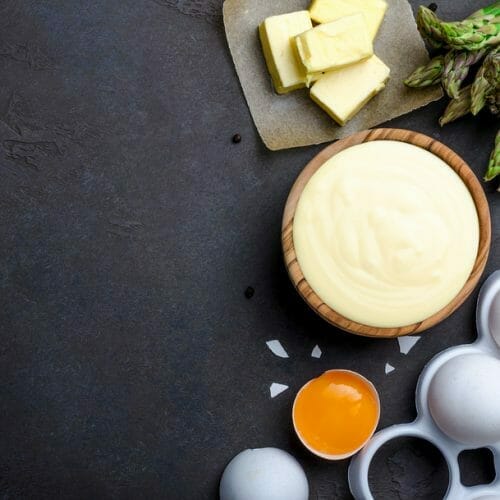Hollandaise Sauce
Hollandaise sauce is also known as Dutch sauce. This sauce is a staple to French cuisine. In fact, among the French, hollandaise sauce is one of the ‘Five mother sauces’. It requires a certain level of mastery to pull off well. But when well done, this sauce is the perfect blend of zesty and silky sweet that goes well with Eggs Benedict, fish or vegetables.
Origin
The hollandaise sauce originated from France although the name, sauce hollandaise is a French phrase that translates into “Dutch sauce” while the name itself is suggestive of a Dutch origin, the connection between the Dutch and the sauce remains unknown.
The first record of this recipe is from 1651, La Varenne’s Le Cuisinier Francois which means “asparagus with fragrant sauce”. Interestingly, in 1667- barely 16 years later, a Dutch recipe that was curiously similar was published. Therefore, the theory that suggested that the sauce had been brought back by the French Huguenots from the exile in Holland remains chronologically impossible.
History and background
La Varenne is largely credited with preserving sauce recipes from the Middle Ages. In fact, some people attribute the invention of hollandaise sauce to him. His writings in La Varenne’s Le Cuisinier are the first recordings of the sauce’s recipe.
In 1651, he wrote: “make a sauce with some good fresh butter, a little vinegar, salt, and nutmeg, and an egg yolk to bind the sauce; take care that it doesn’t curdle”- thus hollandaise sauce was born.
Because the sauce is one of the 5 mother sauces, it works as the foundation for many derivative sauces created by changing a certain aspect of the recipe. For example, form this sauce you can create bearnaise sauce, Sauce au Vin Blanc and several others.
Ingredients
Typical ingredients in a hollandaise sauce are: Butter, egg yolks, lemon juice, salt, white peppercorns, vinegar.
How to make Hollandaise sauce
When it comes to making the perfect hollandaise sauce, it all boils down to striking the perfect balance between the ingredients and how good you whisk.
What matters most when preparing this sauce is controlling the temperature. For that reason, some chefs use a double boiler in order to regulate the temperature. Remember, high temperatures will lead to the sauce getting curdled. If that happens try adding some cold water and whisk all that you can. A good Hollandaise is all about the whisking.
What sauce go well with?
You can serve your hollandaise sauce with a variety of meals. However, this sauce is a commonly and popularly serves with Eggs Benedict. This is because the contrasting flavors in both create a delicious balance that you will definitely appreciate. You can also serve this sauce over stir fried or steamed vegetables such as asparagus. This also goes very well with white fish such as cod, plaice and haddock.

Hollandaise sauce
Ingredients
- 3 pcs Large eggs
- 225 g Butter
- 5 ml White wine vinegar
- 20 ml Water
- 1 tspn Ground white pepper
- 1 tspn Lemon juice
Instructions
- Start by melting the butter in a saucepan over a gentle heat. When all butter is melted then remove the saucepan from the heat.
- Take a new saucepan and heat some water and place a stainless steel bowl or glass on top, and keep on a gentle simmer.
- Pour in the white wine vinegar and lemon juice then add the egg yolks and whisk continuously until the sauce reaches a light and creamy consistency. Be very careful at this stage because the line between creamy and scrambled is very fine.
- Now remove the bowl from the saucepan then pour in the melted butter, whilst continuing to whisk at all times.
- If the sauce is still a little thick after adding all the butter, whisk in some cold water or squeeze in a lemon. Season to taste.

One Response
There are a number of important things to remember here. First the reason lemon juice is added is to raise the temperature at which the egg yolks break to 190 deg Fahrenheit. This prevents the eggs from scrambling. Once you add lemon, it is virtually impossible to scramble the eggs over barely simmering water. This makes a much more forgiving preparation. It is also VERY important to always use fresh eggs. Old egg yolks will never form an emulsion because the lecithin in them has disintegrated. The egg lecithin is what binds the emulsion with the yolks and butter. Old egg yolks go directly from liquid to scrambled and will never bind with butter. Milk solids in the butter add both flavor and loft, so clarifying the butter actually hurts the sauce flavor and wastes time. The emulsification process works better when cold 1/2” cubes of butter are whisked in and the layers of butter melt off gently while the cool cubes of butter keep the sauce temperature moderate as they melt and move through the yolks. Butter also contains added emulsifiers that help the sauce bind, and clarifying the butter removes those emulsifiers which would have helped form the sauce. Finally, water to set consistency should be added at the end, not the beginning. Adding water at the end will make a lighter sauce because air incorporates better with proteins when less water is present.